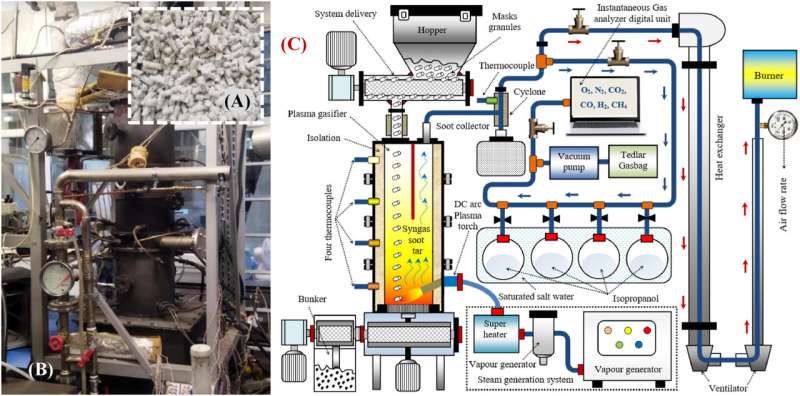This article has been reviewed according to Science X's editorial process and policies. Editors have highlighted the following attributes while ensuring the content's credibility:
fact-checked
peer-reviewed publication
trusted source
proofread
Lithuanian researchers recycle surgical masks for hydrogen-rich gas production

During the COVID-19 pandemic, thousands of tons of used surgical masks were dumped every month without a real vision to manage them. Although the world has successfully passed the critical period, a serious industrial eco-solution must be developed to deal with this waste.
Researchers from Kaunas University of Technology (KTU) and Lithuanian Energy Institute, aiming to design a solution for surgical mask waste management are investigating the possibilities of plasma gasification as an eco-friendly energy technique to convert surgical mask waste into clean energy products.
After conducting a series of experiments, they obtained synthetic gas (aka syngas) with a high abundance of hydrogen. Their research is published in the International Journal of Hydrogen Energy.
"There are two ways of converting waste to energy—by transforming solid waste into liquid product, or gases. Gasification allows converting huge amounts of waste to syngas, which is similar to natural and is a composition of several gases (such as hydrogen, carbon dioxide, carbon monoxide, and methane). During our experiments, we played with the composition of this synthetic gas and increased its concentration of hydrogen, and, in turn, its heating value," says Samy Yousef, a chief researcher at Kaunas University of Technology, Lithuania.
For the conversion of surgical masks, the researchers applied plasma gasification on defective FFP2 face masks, which were shredded beforehand into a uniform particle size, and then converted to granules that could be easily controlled during treatment.
The highest yield of hydrogen was obtained at an S/C (steam-to-carbon ratio) of 1.45. Overall, the obtained syngas showed a 42% higher heating value than that produced from biomass.
Improving a traditional waste management technique
Yousef's research team, composed of scientists from two Lithuanian research institutions, KTU and Lithuanian Energy Institute, are working on the topics of recycling and waste management, and are always looking for waste, which is present in huge amounts and has a unique structure. In their work, they have conducted pyrolysis experiments on cigarette butts, used wind turbine blades, and textile waste, which have all shown promising results for upscaling and commercialization. Yet, this time, for the recycling of surgical masks, a different method was applied.
"Gasification is a traditional waste management technique. Differently from pyrolysis, which is still a new and developing method, we don't need much investment in developing infrastructure. Arc plasma gasification, which we have applied for the decomposition of surgical masks, means that under high temperatures generated by arc plasma, we can decompose face masks to gas within a few seconds. In pyrolysis, it takes up to an hour to get the final product. In advanced gasification, the process is almost instantaneous," explains Yousef.
He says that advanced gasification techniques, such as plasma gasification, are more efficient in obtaining a better concentration of hydrogen (up to 50%) within synthetic gas production. Moreover, plasma gasification decreases the amount of tar in the syngas, which makes its quality higher.
Hydrogen-rich gas has better heating values
According to Yousef, plasma gasification is one of the best methods to obtain synthetic gas, which is rich in hydrogen.
"Hydrogen increases the heating value of the synthetic gas," explains Yousef and continues describing the different types of hydrogen: gray is obtained from natural gas or methane, green—from green sources (e.g., electrolysis), blue—from steam reforming.
"Maybe we could call ours black hydrogen, as it's made from waste?" he says half-jokingly.
The yield of syngas was around 95% of the total amount of feedstock. The remaining products were soot and tar. The analysis revealed that benzene, toluene, naphthalene and acenaphthylene were the main compounds in collected tar. According to the researchers, it can be used as a clean fuel in different industries with low carbon emissions.
The soot was formulated in the last stage of plasma gasification. Its main component is black carbon, which can have numerous applications related to energy, wastewater treatment, and agriculture, or can be used as a filler material in composites.
The researchers believe that their proposed method for surgical mask waste recycling has a high potential to be commercialized. According to Yousef, a researcher from KTU, their main aim was to obtain synthetic gas, which is rich in hydrogen. Although hydrogen can be separated from the obtained syngas, it can also be used as a mixture of gases. As such, it already has half a higher heating value than that produced from biomass.
More information: Samy Yousef et al, Plasma steam gasification of surgical mask waste for hydrogen-rich syngas production, International Journal of Hydrogen Energy (2023). DOI: 10.1016/j.ijhydene.2023.09.288















